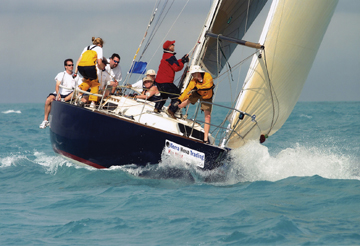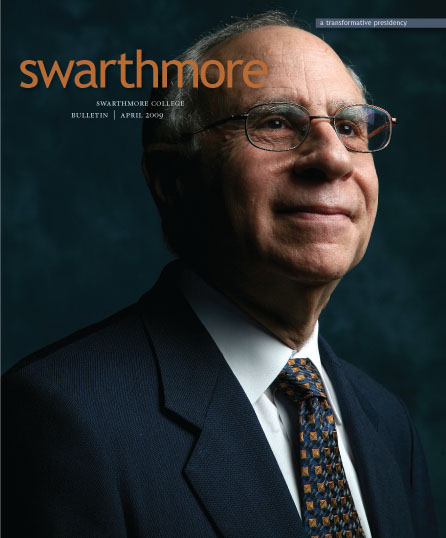Sailboat Racing—Fun But Serious Business
“... hours of incredible boredom, interrupted by moments of stark terror.”

Bowes (above) participated in the Key West Race Week in 2004, off Florida, after Hurricane Ivan. The winds were 11 to 17 knots, and the seas at 2 to 3 feet the day this photo was taken.
There’s a saying that “sailboat racing is hours of incredible boredom, interrupted by moments of stark terror.” Despite this assessment of the sport, Arlene Dannenberg Bowes ’72 is undeterred.
The Philadelphia native is competitive and enjoys a challenge. As a Swarthmore freshman, she helped classmates deliver a Dickerson 35 ketch from Philadelphia to Cape May, during which they were caught up in a squall near the mouth of the Delaware Bay. In 1973, she encountered another kind of challenge when she entered the School of Dental Medicine at the University of Pennsylvania (Penn) at a time when only one percent of American dentists were women.
Bowes is now on the faculty at the school where she earned her dental degree 30 years ago. Since moving to Clifton, Va., she travels to Penn weekly. She also serves as a dental officer with the U.S. Public Health Service (USPHS), which she joined in 1976, periodically helping on Native American reservations or with natural disasters such as Hurricane Katrina. Her first USPHS assignment after Penn was as a dental officer at the U.S. Merchant Marine Academy (USMMA) in Kings Point, N.Y. There, she met her husband Stephen Bowes, a marine engineer and sailor.
Today, the couple races the Apparition, a Frers 41 sloop, which they purchased 10 years ago. The racer-cruiser, designed two decades ago by Germán Frers, an Argentine design group, has eight berths, a galley and enclosed head—that’s nautical jargon for a kitchen and a bathroom with a door, hanging lockers, and a navigation station.
Assisted by a crew of eight, the Boweses annually participate in about 15 events, most involving multiple races. They plot their course on a GPS system and track the competition with a satellite phone.
The first race the Boweses entered with their 15,000 lb. vessel was an eye-opener. “We learned, too late, that the Annapolis racers were professional sailors,” Arlene says. “For example, third place in a three-hour race might mean you were 30 seconds behind the winner.”
Since then, they’ve always placed in the upper third of their fleet and brought home their share of trophies, with Stephen at the helm, and Arlene working as pitcrew, a central position from which she assists in raising and lowering sails. “Since I don’t weigh much compared to the rugby players who race with us, I can haul sails or fetch Snickers bars from below deck without upsetting the boat’s trim, “ she says.
The couple usually races off Annapolis, Md., but has also participated in Block Island (R.I.) and Key West (Fla.) Race Weeks. Twice, they have competed in the Bermuda Ocean Race, 750 nautical miles and three to seven days from Annapolis. During a 2004 race on the Chesapeake Bay, the Apparition was caught in the tail end of Hurricane Ivan. “With the wind at 40 knots, six-foot seas, and the boat traveling at a recording-breaking 13 knots, we were flying,” Arlene recalls. “Then we heard a loud snap. We duct taped the 17-foot broken aluminum boom and headed back. It took four nauseating hours to return to dock, a trip that had taken an hour going south.”
Before the sailors can revel in the thrill of racing, the boat must be maintained and stocked. “Sailboat racing is a fun but serious business,” says Arlene. The sails are Kevlar or carbon fiber and need to be replaced every three or four years. High-tech lines (ropes) are routinely replaced since they carry huge loads, and the electronics require periodic maintenance. The boat’s hull must be kept clean and smooth for speed,” Arlene says. Food, water, safety gear, spare parts, tools, and medical supplies must be on board. Before their first race to Bermuda, the couple became emergency medical technicians and completed safety-at-sea courses.
When the winds lessen in late summer, Stephen takes a 13-foot Laser out on the Occoquan River, which feeds into the Potomac River; Arlene often skims quietly across the same waters in her 33 lb. kayak.
“We have found over the years what it means to be a team, a group stronger as a whole than individually,” Arlene says. “The synergy applies to our professional lives as well as our racing experiences.”
 Email This Page
Email This Page
April 25th, 2009 3:12 pm
Great article. Keep enjoying the sport. Love, Uncle Jimmy
December 19th, 2009 8:41 am
Sorry I missed this in the print version. What's the nautical equivalent of "Happy Trails?"
Love, AD Cous